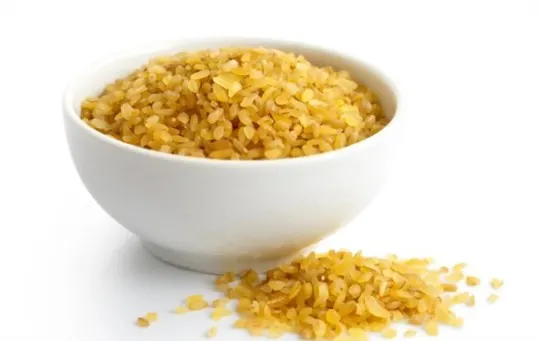In the grand kitchen showdown, we’ve got buckwheat and bulgur vying for the title of Supreme Grain.
Sure, they might look similar at first glance.
One hails from the heart of Asia, while the other’s got Middle Eastern roots.
They’re not just grains; they’re cultural icons.
Here’s a fun fact: buckwheat isn’t even wheat.
It’s more of a distant cousin to rhubarb.
Bulgur? It’s wheat’s pride, pre-cooked and cracked, ready to save dinner.
We’ve messed up a recipe or two mixing them up.
This isn’t just about cooking; it’s about understanding what’s on our plate.
Join us as we dive deep into these grains’ tales.

What is Buckwheat?

Buckwheat is a plant that belongs to the family Polygonaceae.
It has triangular seeds or groats that are typically used in cooking.
These seeds are gluten-free and highly nutritious, making them an excellent option for people with celiac disease or gluten intolerance.
Buckwheat can be consumed in many ways, such as in porridge, pancakes, noodles, and even as a substitute for rice.
Buckwheat is rich in various essential nutrients like minerals, vitamins, amino acids, and fiber.
It contains high levels of magnesium, which helps regulate blood pressure and maintain healthy bones.
Additionally, it has antioxidants that protect against various diseases.
In comparison to bulgur wheat, buckwheat is gluten-free and has a more distinct taste.
Furthermore, it has a lower glycemic index than bulgur wheat due to its high fiber content.
This means that it can help regulate blood sugar levels better than other grains.
Overall, incorporating buckwheat into your diet can have numerous health benefits while also adding delicious flavor to your meals.
What is Bulgur?

Bulgur is a whole grain that is made by removing the outer layer of wheat berries and then boiling, drying and cracking them.
It has a nutty flavor and chewy texture, making it a popular ingredient in salads, pilafs, and tabbouleh.
Bulgur is also high in fiber, protein, and essential nutrients like magnesium, iron and manganese.
Its low glycemic index makes it ideal for people with diabetes or those looking to regulate blood sugar levels.
Differences Between Buckwheat and Bulgur

The contrast between Buckwheat and Bulgur lies in their composition, processing, nutritional benefits, and uses.
Buckwheat is made from the seeds of a plant and has a nutty flavor, while Bulgur is produced by cracking wheat grains.
Buckwheat is gluten-free and an excellent source of protein, fiber, manganese, and magnesium.
In comparison, bulgur offers high amounts of fiber, vitamins B6, E and K, potassium as well as iron.
Both grains are prevalent in various dishes globally; however, buckwheat is more popular in Asian countries while bulgur features more prominently in Mediterranean cuisine.
1 – Origin and Plant Source
The origin and plant source of buckwheat and bulgur has an interesting history.
While buckwheat is not classified as a grain, it’s still considered as one due to its impressive nutritional profile.
It’s also gluten-free and derived from seeds of a flowering plant related to rhubarb.
In contrast, bulgur is made by boiling wheat berries, drying them, followed by removing the hulls.
Thus, it is a type of whole wheat grain that is often used in Mediterranean and Middle Eastern cuisines.
2 – Nutritional Composition
The nutritional makeup of buckwheat and bulgur differ in several aspects.
While both grains are high in dietary fiber, buckwheat has a greater protein content than bulgur.
On the other hand, Bulgur contains more carbohydrates and has a higher glycemic index compared to buckwheat.
It is also an excellent source of vitamins and minerals such as iron and magnesium, which could prove beneficial for individuals with certain dietary requirements.
3 – Cooking Methods and Culinary Uses
When it comes to using buckwheat and bulgur in cooking, there are various methods that one can use and different culinary uses that can be achieved.
Buckwheat, for example, is often used as a substitute for rice or potatoes and can be cooked by boiling with water or broth, simmering, or even baking.
It is commonly used in salads, soups or stews and its unique nutty flavor is excellent in bread and pancakes.
On the other hand, bulgur is typically prepared by boiling or soaking it before being added to salads, pilafs or stuffing for vegetables like peppers.
It’s also an essential ingredient in Middle Eastern dishes like tabbouleh salad and kibbeh and has a distinct taste that pairs well with tomatoes, herbs and spices.
In terms of nutritional value, both have high fiber content, but buckwheat contains more protein while bulgur has more carbohydrates.
Ultimately the choice between the two may depend on one’s dietary goals or culinary preferences.
4 – Texture and Flavor Profile
The nature of texture and flavor play an important role in distinguishing Buckwheat and Bulgur.
While the former has a nuttier taste, the latter boasts a chewier texture.
Buckwheat is versatile in its use as it can be utilized to create multiple dishes such as gluten-free pancakes, porridge, or risotto.
In contrast, Bulgur is best suited for creating Middle Eastern salads and dishes like Tabouli or Kibbeh.
The two grains are significantly different even though they share similar characteristics like their protein content.
Similarities Between Buckwheat and Bulgur

Both buckwheat and bulgur are healthy whole grains with notable similarities.
They are excellent sources of fiber, protein, and several essential vitamins and minerals.
Buckwheat and bulgur both have nutty flavors that add taste to meals.
They can be used as substitutes for rice or quinoa, making them versatile additions to any meal.
Moreover, both types of grains are easy to prepare and cook quickly compared to some other grains.
You can cook them alone or use them as the base for salads or stews.
These grains also have a long shelf life when stored correctly in a cool dry place.
Buckwheat and bulgur also share the benefit of being gluten-free alternatives for people with celiac disease or gluten sensitivities.
However, buckwheat is a pseudo-cereal that is not directly related to wheat or other cereal plants like bulgur.
Overall, these similarities make buckwheat and bulgur viable choices for health-conscious individuals seeking nutritious and versatile grain options.
Health Benefits of Buckwheat and Bulgur
Buckwheat and Bulgur are healthy alternatives to regular grains, offering a variety of benefits for the human body.
These superfoods are high in fiber, protein, and other essential nutrients that our body needs to function properly.
Moreover, buckwheat is full of antioxidants that support heart health while Bulgur contains significant soluble fiber that helps decrease cholesterol levels.
In addition, Buckwheat is gluten-free and an excellent source of magnesium which aids in blood sugar regulation.
On the other hand, Bulgur has a low glycemic index making it a great food for regulating blood sugar.
Furthermore, its easy digestion makes it an ideal grain alternative for people with gastrointestinal issues.
Both grains are delicious and versatile; they can be added to salads or used as a substitute for rice or pasta dishes.
Adding these nutrient-dense foods into your diet will improve your overall health and wellbeing.
Overall, the Health Benefits of Buckwheat and Bulgur are abundant; their unique nutrients combined with their versatility in cooking make them excellent additions to any balanced diet.
Where to Buy Buckwheat and Bulgur?
Looking to buy buckwheat or bulgur? Here’s where to start.
- Visit your local supermarket and check the grains or international food sections for both buckwheat and bulgur.
- You can also find both grains at health food stores like Whole Foods Market.
- If you prefer online shopping, websites like Amazon and Thrive Market offer a variety of options for both grains.
- Additionally, ethnic grocery stores may have specific brands or types of buckwheat and bulgur that you cannot find elsewhere.
It is important to note that there may be regional variations in availability and brand choices depending on your location.
Therefore, it may be helpful to call ahead before making a trip to a store or ordering online.
Conclusion
Buckwheat and bulgur are both nutrient-dense grains that provide health benefits.
However, they differ in taste, texture, preparation and nutritional value.
Buckwheat is gluten-free and is rich in antioxidants, whereas Bulgur is high in fiber and protein.
When deciding between the two grains, it comes down to personal preference and dietary requirements.
It is essential to choose the grain that meets your specific needs for a healthy diet.

Leave a comment